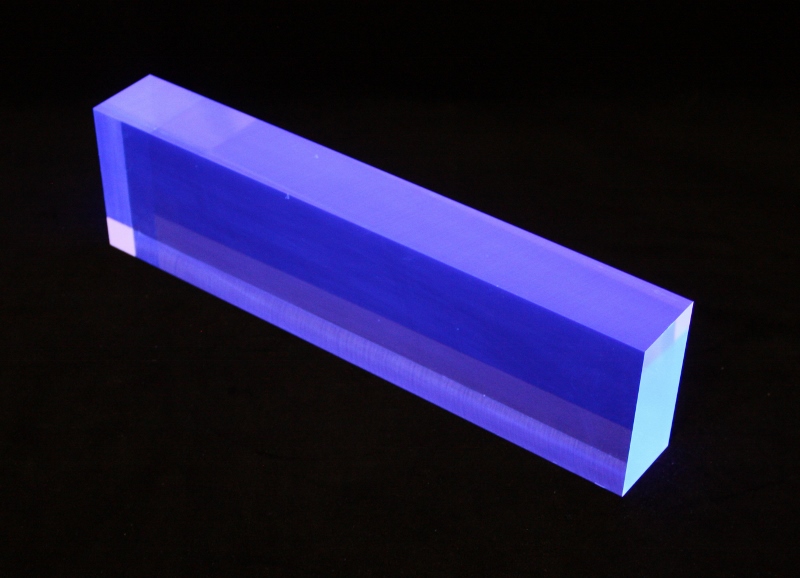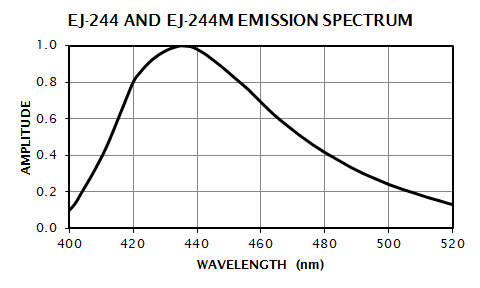HIGH TEMPERATURE
EJ-244, EJ-248, EJ-244M, EJ-248M

EJ-244 and EJ-248 are respective analogs of the popular EJ-208 and EJ-200, possessing their long optical attenuation length and overall superior scintillation properties while being able to be used at somewhat higher temperatures. While both EJ-208 and EJ-200 have softening points near 70°C, these plastics have softening temperatures at 99°C. These higher temperature characteristics have been achieved by using a specially modified variant of the conventional PVT base plastic. Hence, they have the temperature characteristic of polystyrene-based plastics while not suffering the lower scintillation efficiencies associated with polystyrene. These plastics are also mechanically more robust, more easily machined, and more resistant to scratching than the conventional PVT-based materials.
EJ-244M and EJ-248M are respective analogs of EJ-244 and EJ-248 with the additional property of the base polymer being crosslinked. The thermal softening point (99°C) and the scintillation properties of these plastics are the same as for the standard EJ-244 and EJ-248. Crosslinking can be helpful when the plastic scintillator may be used for extended periods at temperatures which clearly exceed the softening point. In such cases, the plastic will soften but, because of the crosslinking, will not flow or undergo a major change in shape. These plastics are best used only in compact physical forms such as small cylinders or blocks.
While intended for higher temperature applications, these scintillators are optimized for use where the scintillator will experience only short intervals at elevated temperatures. These scintillators have been additionally fortified against the accelerated yellowing that occurs with any organic polymer when operated at elevated temperatures; however, continuous use at elevated temperatures will shorten the overall lifetime of the scintillator. To maximize the scintillator lifetime for continued use at elevated temperatures, extra care should be taken to eliminate or minimize the presence of air in the scintillator housings.
| PROPERTIES | EJ-244 |
EJ-248 |
EJ-244M |
EJ-248M |
| Light Output (% Anthracene) | 56 | 60 | 56 | 60 |
| Scintillation Efficiency (photons/1 MeV e-) |
8,600 | 9,200 | 8,600 | 9,200 |
| Wavelength of Maximum Emission (nm) | 434 | 425 | 434 | 425 |
| Light Attenuation Length (cm) | 270 | 250 | 270 | 250 |
| Rise Time (ns) | 1.0 | 0.9 | 1.0 | 0.9 |
| Decay Time (ns) | 3.3 | 2.1 | 3.3 | 2.1 |
| Pulse Width, FWHM (ns) | 4.2 | 2.5 | 4.2 | 2.5 |
| No. of H Atoms per cm3 (x1022) | 5.18 | 5.18 | 5.18 | 5.18 |
| No. of C Atoms per cm3 (x1022) | 4.69 | 4.69 | 4.69 | 4.69 |
| No. of Electrons per cm3 (x1023) | 3.34 | 3.34 | 3.34 | 3.34 |
| Density (g/cm3) | 1.023 | 1.023 | 1.023 | 1.023 |
| Polymer Base | Polyvinyltoluene | |||
| Refractive Index | 1.58 | |||
| Softening Point | 99°C | |||
| Vapor Pressure | Vacuum-compatible | |||
| Coefficient of Linear Expansion | 7.8 x 10-5 below 70°C | |||
| Light Output vs Temperature |
At 60°C, L.O. = 95% of that at 20°C
At 90°C, L.O. = 87% of that at 20°C
No change from -60°C to 20°C
|
|||
| Temperature Range |
-60°C to 90°C *
|
|||
* For optimum long term performance, do not use at temperatures exceeding 60°C for extended periods of time.
|
Chemical Compatibility
Attacked by: Aromatic solvents, Chlorinated solvents, Ketones, Solvent bonding cements, etc.
Stable in: Water, Dilute acids and alkalis, Lower alcohols, and Silicone greases.
It is safe to use most epoxies with these scintillators.
|

